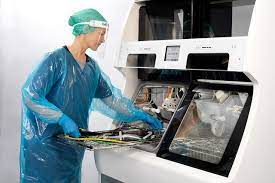Advancements in Endoscope Reprocessing Devices: Ensuring Patient Safety
Endoscopy is a vital medical procedure that allows
healthcare professionals to diagnose and treat various gastrointestinal and
respiratory conditions. To ensure patient safety and reduce the risk of
infections, the proper reprocessing of endoscopes is of utmost importance. Over
the years, significant advancements in endoscope reprocessing devices have
revolutionized healthcare practices, enhancing patient outcomes and overall
safety.
1. Automated Reprocessing: Precision and Efficiency
One of the most significant advancements in endoscope
reprocessing devices is the introduction of automated systems. These devices
have streamlined the cleaning, disinfection, and sterilization processes,
reducing the chances of human error. Automated reprocessing systems ensure
consistent and precise cleaning, achieving a level of disinfection that manual
methods might struggle to match. With programmable cycles and real-time
monitoring, these devices provide healthcare professionals with the confidence that
endoscopes are thoroughly disinfected before their next use.
2. High-Level Disinfection Technologies
Traditional methods of endoscope reprocessing relied on
manual cleaning and chemical disinfection. However, advancements in technology
have introduced high-level disinfection technologies that significantly improve
the effectiveness of the reprocessing process. Examples include advanced
chemical solutions, hydrogen peroxide gas plasma systems, and peracetic acid
disinfectants. These methods offer a higher degree of microbial kill, ensuring
that potentially harmful pathogens are eliminated, leading to enhanced patient
safety.
3. Single-Use Devices: Minimizing Cross-Contamination
Single-use endoscopes have emerged as a game-changer in
endoscope reprocessing. These devices are designed for a one-time procedure and
are then safely disposed of. By eliminating the need for reprocessing
altogether, the risk of cross-contamination is significantly reduced.
Single-use endoscopes not only enhance patient safety but also simplify the
reprocessing workflow for healthcare facilities, saving time and resources.
4. Tracking and Documentation Systems
Endoscope
reprocessing devices have become equipped with advanced tracking and
documentation systems. These technologies record crucial data at each step of
the reprocessing cycle, including cycle times, temperature, pressure, and
chemical exposure. This data can be stored electronically, facilitating easy
access and retrieval during audits and inspections. By ensuring accurate tracking
and documentation, healthcare facilities can maintain compliance with
reprocessing standards and provide a higher level of patient safety.
5. Training and Education Programs
As endoscope reprocessing devices become more sophisticated,
it is essential for healthcare professionals to receive proper training on
their operation and maintenance. Advancements in endoscope reprocessing devices
have prompted the development of comprehensive training and education programs.
These initiatives aim to equip staff with the knowledge and skills necessary to
handle the devices effectively, thereby enhancing patient safety by reducing
the likelihood of errors in reprocessing procedures.
In conclusion, advancements in endoscope reprocessing
devices have had a profound impact on patient safety and healthcare practices.
The introduction of automated reprocessing systems, high-level disinfection
technologies, and single-use devices has revolutionized the way endoscopes are
handled. Moreover, tracking and documentation systems, coupled with
comprehensive training programs, ensure that healthcare facilities can maintain
compliance and provide the highest standard of patient care. As technology
continues to evolve, the field of endoscope reprocessing is likely to witness even
more innovations that will further improve patient safety and overall
healthcare outcomes.




Comments
Post a Comment